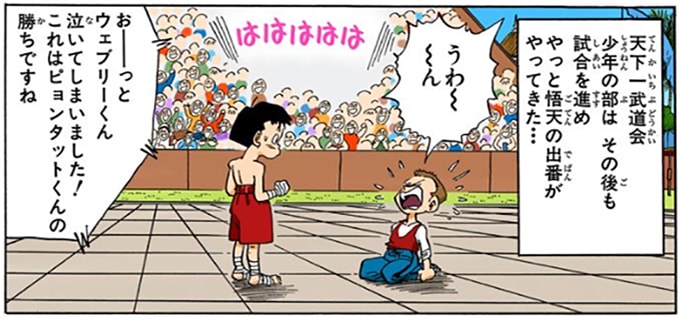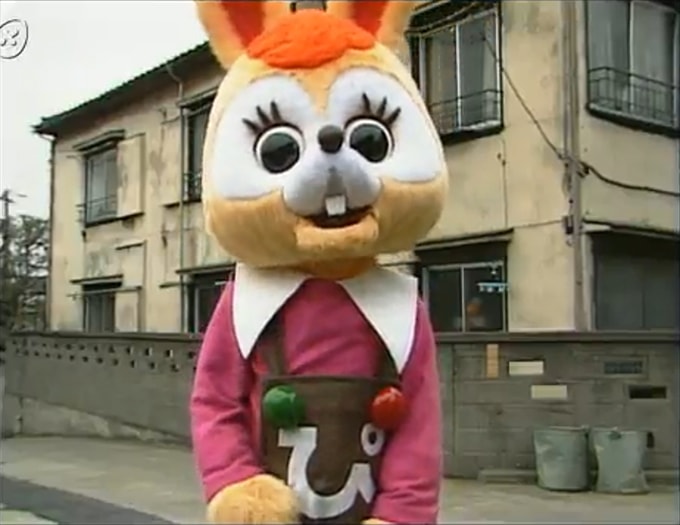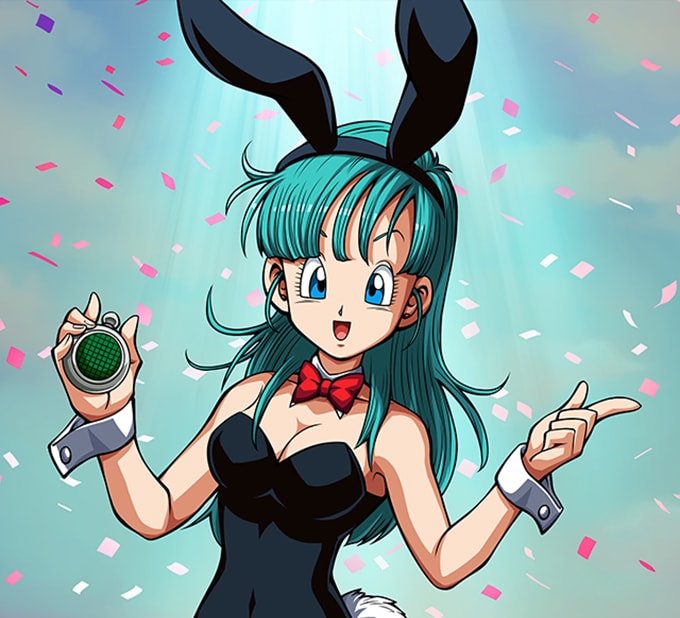Pyontatto’s Name Explained

Who is Pyontatto? Even Akira Toriyama forgets the origin of this character’s name. So let’s go down the rabbit hole to reveal the mystery of Pyontatto!
Pyontatto only appears in a single panel of a single chapter (Chapter 433), and most fans forget that he even exists, let alone remember his name.
Pyontatto (ピョンタット) is a young martial artist that competes in the junior division of the 25th Tenkaichi Budōkai. This is the tournament in the Majin Buu arc where Goten and Trunks fight alongside a bunch of normal children on the way to the finals. Pyontatto is one of these children.
During the tournament, Pyontatto stands on stage to fight Ueburī (ウェブリー, “Webley”). However, instead of fighting him, Ueburī breaks down in tears and is disqualified before a punch can be thrown. As a result, Pyontatto advances to the next round with ease.
The source of inspiration for Pyontatto’s name has never been defined in the official Dragon Ball guidebooks. Akira Toriyama says in Dragon Ball Forever:
“I don’t think this name is supposed to sound like much of anything. I can’t remember.”
However, after a great deal of effort I believe I have found the source of Pyontatto’s name.
Pyon-Pyon

Pyon-pyon (ぴょんぴょん, “jump-jump”) is the Japanese onomatopoeia for the sound that rabbits, frogs, and other hopping animals make when they jump. It’s the Eastern equivalent of the Western ‘hop-hop.’
For example, here’s a children’s song called Pyon-pyon kaeru (ぴょんぴょんかえる, “Hop-Hop Frog“) that teaches kids about different animals jumping:
There’s also the Japanese version of the Tortoise and the Hare fable, which is often sung as a nursery rhyme (originating in 1901). The phrase “pyon-pyon-pyon-pyon” occurs at 1:30:
In Japan, the association between pyon-pyon and rabbits leads to a famous anthropomorphic rabbit character on TV named Pyonta (ぴょん太).

This costumed character is the host of the NHK children’s television show Pyonta-no-anzen-nikki (ぴょん太の安全日記, “Pyonta’s Safety Diary,” 1980—1986).[1]
You can watch the start of the first episode here and on NHK’s official website.
Pyonta-kun is voiced by Masako Nozawa, the voice of Son Gokū in Dragon Ball.
This live-action program teaches safety issues related to children’s lives, such as crossing the street, playing at the park, and swimming in pools.
In each episode of Pyonta-no-anzen-nikki, Pyonta-kun will carelessly get into life-threatening danger, such as getting hit by a truck while in the street, and then Pyonta-kun and the children will learn a lesson from the adult hosts of the show about how to stay safe.
The character is referred to as Pyonta-kun (ぴょん太くん) in the show. Pyonta-kun is also a popular name for pet rabbits in Japan, similar to “Hoppy.”
The word pyonta is often used with the word to (と, “and”). In fact, during the introduction for each episode the singer says the word “Pyontatto” as the titular rabbit jumps on screen.[2]
Pyonta to Pyontatto

How does Pyonta lead to Pyontatto?
The onomatopoeia of pyon-pyon can also be applied to people. Here it means to “jump over something with ease” or “jump up and down repeatedly.” In time, the derivative of pyontatto has become slang that means “to jump ahead with ease.”
This is what Pyontatto does in his match with Ueburī, where he wins the fight without fighting. He ‘jumps ahead with ease’ to the next round.
This is an example of Toriyama using what I call a ‘self-referential name.’ These are names whose sole purpose is to define the character by how their actions or the scenario they are placed in refers back to themselves.
Toriyama often uses self-referential names for comedic purposes. They are given to throwaway characters who appear in a single scene and are then defeated with ease by the main characters. This is done in order to show how strong the main characters are, or to break the tension with a lighthearted joke.
Other examples include Nokku, Mō Kekko, and Panputto.
For example, Nokku is (ノック) is inspired by the foreign loan word of nokku-auto (ノックアウト, “knock out”), and he is literally knocked-out by Vegeta with a single back-fist.
Toriyama does a similar thing here with Pyontatto. He names a child character after the onomotopeia of pyon-pyon and Pyonta-kun in order to connect him with ‘jumping ahead,’ and then that’s exactly what he does.
The scenario Pyontatto is placed in is funny on its own right, but it becomes even funnier when it’s understood as an expression of the winner’s name.
Pyontatto’s name is the sole reason why this scene exists in the first place.
Jumping Ahead
What do you think of my theory? Toriyama cannot remember the origin of Pyontatto’s name, but most names in Dragon Ball are rooted in cultural lore, either Eastern or Western, so I worked hard to find a logical source.
Given that this is the children’s division of the tournament, and that Toriyama is writing his manga for 12-year-old Japanese boys, I figure he chose this name because his young audience would be familiar with the show, with hopping animals, with the onomatopoeia, and the association of ‘jumping ahead,’ which is what Pyontatto does.
All of this for a single character in a single panel who literally does nothing.
There you have it. Over 24 years later and we have an explanation for Pyontatto’s name.
You can find more lost and forgotten names like Pyontatto’s explained in my upcoming book, Dragon Ball Language.
Footnotes
[1] Pyonta-no-anzen-nikki (ぴょん太の安全日記, “Pyonta’s Safety Diary,” 1980—1986) is one of several similar shows that ran on NHK throughout the 1960s to the end of the ‘80s. A precursor show is Anzen kyōshitsu (安全教室, or あんぜんきょうしつ, “Safety Classroom,” April 9, 1969 to March 17). A predecessor is Anzen Patorōru (あんぜんパトロール, “Safety Patrol,” April 9, 1986, to March 16, 1993).
[2] Nozawa Masako is the voice of Pyonta-kun in Pyonta-no-anzen-nikki. She is the same seiyū of Son Gokū. The final broadcast date of Pyonta-no-anzen-nikki is March 19, 1986, and Dragon Ball Episode 1 premieres on February 26, 1986.